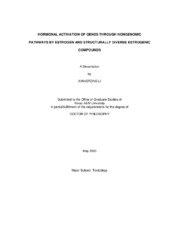| dc.description.abstract | Lactate dehydrogenase A (LDHA) is hormonally regulated in rodents, and increased expression of LDHA is observed during mammary gland tumorigenesis. The mechanisms of hormonal regulation of LDHA were investigated in breast cancer cells using a series of deletion and mutant reporter constructs derived from the rat LDHA gene promoter. Results of transient transfection studies showed that the -92 to -37 region of the LDHA promoter was important for basal and estrogen-induced transactivation, and mutation of the consensus CRE motif (-48/-41) within this region resulted in significant loss of basal activity and hormone-responsiveness. Gel mobility shift assays using nuclear extracts from MCF-7 cells indicated that CREB family proteins interacted with the CRE. Studies with kinase inhibitors showed that estrogen-induced activation of this CRE was dependent on protein kinase C, and these data show that LDHA is induced through a nongenomic (extranuclear) pathway of estrogen action. Estrogen activates several nongenomic pathways in MCF-7 cells, and this study investigated the effects of structurally diverse estrogenic compounds on activation of mitogen activated protein kinase (MAPK), phosphatidylinositol 3-kinase (PI3K), protein kinase C (PKC), protein kinase A (PKA), and calcium/calmodulin-dependent protein kinase IV (CaMKIV). Activation of kinases was determined by specific substrate phosphorylation and transactivation assays that were diagnostic for individual kinases. The compounds investigated in this study include E2, diethylstilbestrol (DES), the phytoestrogen resveratrol, and the following synthetic xenoestrogens: bisphenol-A (BPA), nonylphenol, octylphenol, endosulfan, kepone, 2,2-bis(p-hydroxyphenyl)-1,1,1-trichloroethane (HPTE), and 2',3',4',5'-tetrachloro-4-biphenylol (HO-PCB-Cl4). With theexception of resveratrol, all the compounds activated PI3K and MAPK whereas activation of PKC by the xenoestrogens was structure-dependent and resveratrol, kepone and HO-PCB-Cl4 were inactive. Only minimal estrogen/xenoestrogen-dependent activation of PKA was observed. CaMKIV was activated only by E2 and DES, and HO-PCB-Cl4 was a potent inhibitor of CaMKIV-dependent activity. These results demonstrate that activation of nongenomic pathways by estrogenic compounds in MCF-7 cells is structure-dependent. | en |


